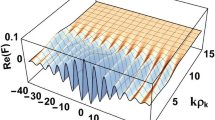Abstract
A quantum theory of the photon is developed in a natural manner. Newton-Wigner and Wightman demonstrated that the photon could not be strictly localized according to natural criteria. These investigations involved the identification of an elementary system with a uirrep of the Poincare group. We identify a particle with the localized measurement of the states satisfying the uirrep. In the case of zero mass and unit spin, the photon is identified with those components of the state that can be localized. A c-number four-vector potential and Lorentz condition are derived from the relativistic wave equation. The Wightman localization is demonstrated for the three independent space components of the vector potential, and the photon is identified with these components. A position operator and probability density follow immediately from the localization. A consequence of the subjective definition of a photon is that the transformations of the vector potential are unitary, and hence the unitary scalar product can be obtained for the four-vector potential. A Hilbert space is defined for the three space components of the vector potential. A position operator and probability density are derived from the scalar product, which compare directly with those obtained from the localization and the non-relativistic theory. As the longitudinal and scalar polarizations do not contribute to the measured transition probability, they are considered virtual. Lastly, a conserved four-vector current is derived from the scalar product. The possibility of observing a strict localization of the photon in the laboratory is suggested.
Similar content being viewed by others
References
T. D. Newton and E. P. Wigner,Rev. Mod. Phys. 21, 400 (1949).
L. Landau awd R. Peierls,Z. Phys. 62, 188 (1930);69, 56 (1931).
W. Pauli,Collected Scientific Papers, R. Kronig and V. F. Weisskopf, eds. (Interscience, New York, 1964), Vol. 2, p. 608.
M. H. L. Pryee,Proc. R. Soc. 195A, 62 (1948).
A. S. Wightman,Rev. Mod. Phys. 34, 845 (1962).
H. Bacry,Lecture Notes in Physics, Vol. 308 (Springer, Berlin. 1988).
E. R. Pike and S. Sarkarv inFrontiers in Quantum Optics. E. R. Pike and S. Sarkar, eds. (Hilger, Bristol, 1986).
D. Rosewarne and S. Sarkar,Quantum Opt. 4, 405 (1992).
A. J. Kalnay, inProblems in the Foundations of Physics. Mario Bunge, ed. (Springer, Berlin, 1971).
D. Han, Y. S. Kim and Marilyn E. Noz,Phys. Rev. A 35, 1682 (1987).
Henri Bacry,J. Phys: Math. Gen. 26 5413. (1993).
Y. S. Kim and E. P. Wigner,Phys. Rev. A. 36, 1293 (1987).
G. W. Mackey,Unitary Group Representations in Physics, Probability and Number Theory (Addison-Wesley, New York, 1989).
C. K. Hong and L. Mandel,Phys. Rev. Lett. 56, 58 (1986).
E. Wigner,Ann. Math. 40, 149 (1939).
E. Wigner,Nuovo Cimento 3, 517 (1956).
V. Bargmann and E. P. Wigner,Proc. Natl. Acad. Sci. 34, 211 (1948).
D. Lurié,Particles and Fields (Interscience, New York, 1968).
S. Twareque Ali,Riv. Nuovo Gimento 8, 1 (1985).
For a discussion in the context of massive particles, see S. N. M. Ruijsenaars,Ann. Phys. 137, 33 (1981).
S. N. Gupta,Proc. Phys. Soc. 63, 681 (1950).
K. Bleuler,Helv. Phys. Acta. 23, 567 (1950).
S. Weinberg,Phys. Rev. B 138, 988 (1965):Phys. Rev. B 134, 882 (1964).
D. Han, Y. S. Kim and D. Son,Am. J. Phys. 54, 818 (1986.
D. Han, Y. S. Kim and D. Son,Phys. Rev. D 26, 3717 (1982).
D. Han and Y. S. Kim,Am. J. Phys. 49, 348 (1981).
N. Shnerb and L. P. Horwitz,J. Math. Phys. 35, 1658 (1994).
D. Han, Y. S. Kim and D. Son,Phys. Rev. D. 3, 328, (1985).
Chr. MØller,Commun. Dublin Inst. Adv. Studies A 5, (1949); also A. Papapeltou,Acad. Athens 14, 540 (1939).
D. G. Currie, T. F. Jordan, and E. C. G. Sudershan,Rev. Mod. Phys. 35, 350 (1963).
W. O. Amrein,Helv. Phys. Acta 42, 149 (1969).
Gordon N. Fleming,Phys. Rev. B 139, 963 (1965):J. Math. Phys. 7, 1959 (1966).
S. C. McDonald,J. Math. Phys. 11, 1558 (1970).
D. P. L. Castrigiano and U. Mutze,Phys Rev. D 26 3499 (1982).
A. A. Broyles,Phys. Rev. D 1, 979 (1970).
Joseph E. Johnson,Phys. Rev. D 3, 1735 (1971).
Where the detector can be a quantum system, and the measurement theory is unitary.
A. Einstein,Ann. Phys. 132, 17 (1905); English translation by A. B. Arons and M. B. Peppard.Am. J. Phys. 367, 33 (1965).
Richard P. Feynman, Robert B. Leighton, and Mathew Sands.The Feynman Lectures on Physics, Vol. III (1965). For experiments that involve the photon, see. e.g., B. C. Sanders and G. J. Milburn,Phys. Rev. A 39, 694 (1989); Thomas J. Herzog, Paul G. Kwiat, Harald Weinfurter, and Anton Zeilinger,Phys. Rev. Lett. 75, 3034 (1995).
Assuming for the purpose of discussion that such a basis exists.
H. D. Zeh,Phys. Lett. A 172, 189 (1993).
Alternatively, for example, the system is localized in a volumeS, a Borel subset of a spacelike hyperplaneσ in Minkowski space.1341.
D. Han, Y. S. Kim, Marilyn E. Noz, and D. Son,Am. J. Phys. 52, 1037 (1984).
D. Han, Y. S. Kim, and D. Son,Phys Lett. B 131, 327 (1983).
While the states χμ∈L 2(V +) are invariant with respect to the transformations (42) required for localization, the change of basis (32) ensures the correct form of the scalar product for localized states.
Roy J. Glauber,Phys. Rev. 131, 2766 (1963); Rodney London,The Quantum Theory of Light (Clarendon, Oxford, 1973).
J. M. Jauch and C. Piron,Helv. Phys. Acta 40, 559 (1967).
P. A. M. Dirac,The Principles of Quantum Mechanics (Clarendon, Oxford, 1962), §22.
L. Fonda and G. C. Ghirardi,Nuovo Cimento 56A, 1094 (1968).
L. Mandel,Phys. Rev. 144, 1071 (1966).
W. Greiner,Relativistic Quantum Mechanics (Springer, Heidelberg, 1990).
Author information
Authors and Affiliations
Rights and permissions
About this article
Cite this article
Ingall, J.E.M. The Newton-Wigner and Wightman localization of the photon. Found Phys 26, 1003–1031 (1996). https://doi.org/10.1007/BF02061401
Received:
Revised:
Issue Date:
DOI: https://doi.org/10.1007/BF02061401




